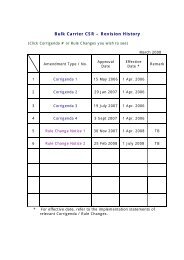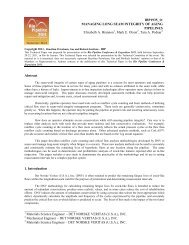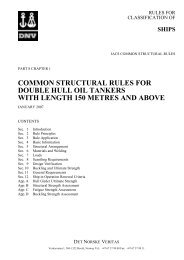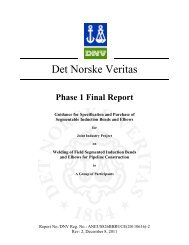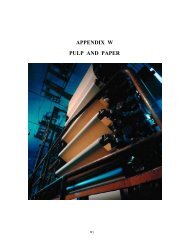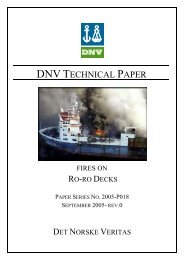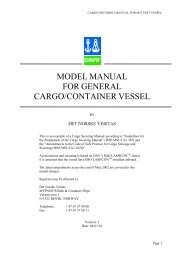InSitu Analysis of Pipeline Metallurgy - dnV
InSitu Analysis of Pipeline Metallurgy - dnV
InSitu Analysis of Pipeline Metallurgy - dnV
You also want an ePaper? Increase the reach of your titles
YUMPU automatically turns print PDFs into web optimized ePapers that Google loves.
11. B.L. Bramfitt, “Structure/Property Relationships in Irons and Steels”, Metals Handbook DeskEdition, Second Edition, J.R. Davis, editor, 199812. K. Sharma, P.K. Singh, et al., “Application <strong>of</strong> Automated Ball Indentation for Property Measurement<strong>of</strong> Degraded Zr2.5Nb” Journal <strong>of</strong> Minerals & Materials Characterization & Engineering, Vol. 10,No.7, pp.661-669, 201113. J.R. Foulds, M. Wu, S. Srivastav, and C.W. Jewett, “Fracture and Tensile Properties <strong>of</strong> ASTMCross Comparison Exercise A 533B Steel by Small Punch Testing”, Small Speciman Testtechniques, ASTM STP 1329, W.R. Corwin, S.T. Rosinski, E. van Walle editiors, ASTM, 1998ATTACHMENT 1COLLECTION OF STEEL FILINGS FOR CHEMICAL ANALYSISMATERIALS / TOOLS NEEDEDSample containerCarbide burrElectric or pnuematic drill with 3/8 inch chuckTools to remove pipe coatingGrinder or drill equipped with coarse to medium grit sanding disks (example: 40-100 grit)File folder or similar stiff paper or cardboard approx. 12x 18 inches or larger (when opened flat)Duct tape or similarSafety glasses / gogglesMagnetPlastic wrap or plastic bagPROCEDURE1. Strip coating from pipe in area approximately 1 ft x 1 ft located at approximately the 1:00 to 3:00position2. Use sanding disks or grinder to remove pipe coating residue and any other contamination from areaapprox. 9 x 9 inches. Metal should be shiny with no specks <strong>of</strong> dirt, rust, oxide scale, paint, or otherforeign material present. For best results remove about 0.01 inches <strong>of</strong> thickness before starting thecollection <strong>of</strong> filings3. Open the file folder and tape one 12-inch side <strong>of</strong> file folder to bottom <strong>of</strong> cleaned area on the pipe.Run the tape along the entire edge <strong>of</strong> the folder. The open file folder should now be hanging downfrom the pipe.4. Fold the file folder in half to form a vee-shaped trough into which steel filings can fall5. Use two pieces <strong>of</strong> tape (one on each side) to bridge across the two sides <strong>of</strong> the vee so that whenyou let go <strong>of</strong> the file folder the “vee” shape still remains. The “loose” or unattached side <strong>of</strong> the filefolder will stand out from the pipe at about a 30-45 degree angle6. Hold the drill against the cleaned pipe so that the direction <strong>of</strong> burr rotation will push the steelshavings into the bottom <strong>of</strong> the vee-shaped file folder trough.7. Use a drill speed which allows you to control the direction and distance that the steel shavings arethrown. A burr RPM that is too fast will cause the chips to be flung past the collection trough.8. Check the burr occasionally for evidence <strong>of</strong> chipped cutting edges. If the burr is chipped thendiscard the filings, mount a new burr, and continue collecting filings9. Peel the tape <strong>of</strong>f the pipe while being careful not to spill the filings10. Dump the filings into the sample container if no evidence <strong>of</strong> chipping is seen on the burr teeth.11. Reattach the file folder as in step 3-5 and continue to collect filings.





